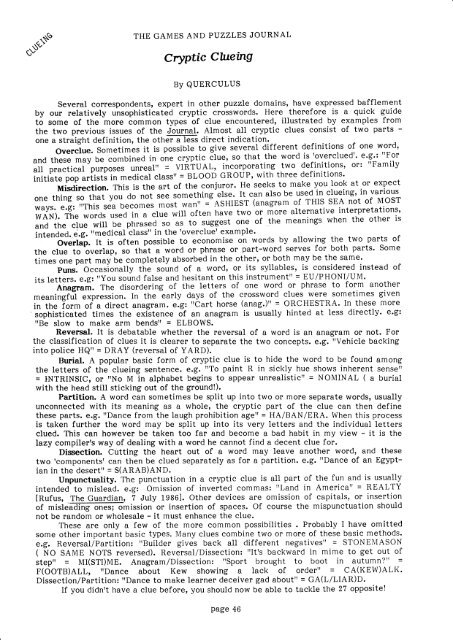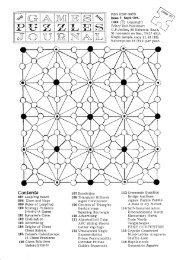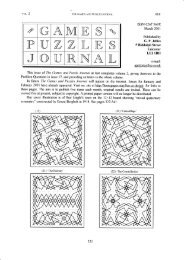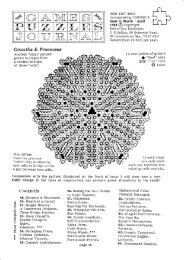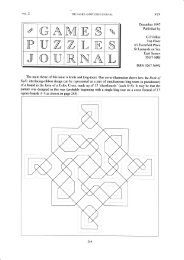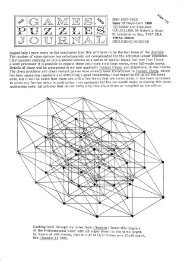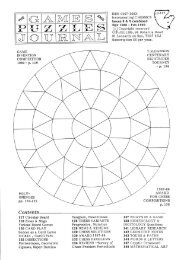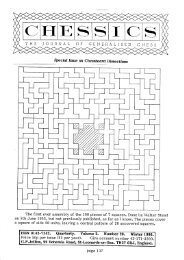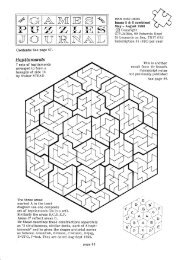The Games and Puzzles Journal, #3 - Mayhematics
The Games and Puzzles Journal, #3 - Mayhematics
The Games and Puzzles Journal, #3 - Mayhematics
- No tags were found...
You also want an ePaper? Increase the reach of your titles
YUMPU automatically turns print PDFs into web optimized ePapers that Google loves.
$<br />
THE GAMES AND PUZZLES JOURNAL<br />
Cryptfc Chrcing<br />
BY QUERCULUS<br />
Several correspondents, expert in other puzzle domains, have expressed bafflement<br />
by our relatively unsophisticated cryptic crosswords. Here therefore is a quick g-uide<br />
to some of the more iommon types of clue encountered, illustrated by examples from<br />
the two previous issues of the <strong>Journal</strong>. Almost all cryptic clues consist of two parts -<br />
one a straight definition, the other a less direct indication.<br />
overclue. sometimes it is posiible to give several different definitions of one word,<br />
<strong>and</strong> these may be combined in one cryptic ilue, ro that the word is tovercluedt. e.g.: "For<br />
all practicat purposes unreailr = vtRtuAL, incorporating two definitions, or: "Family<br />
initilt" pop in medical class'r = BLOOD GROUP, with three definitions'<br />
Misdirection. "riirtr This is the art of the conjuror. He seeks to make you look at or expect<br />
one thing so that you do not see something else-. It can also be used in clueing' in various<br />
ways. e.g: I'This sea becomes wan'r ="ASHIEST (anagram of THIS SEA not of MosT<br />
-most<br />
wAN). <strong>The</strong> words used in a clue will often have two ot mote alternative interpretations'<br />
<strong>and</strong> the clue will be phrased so as to suggest one of .-the meanings when the other is<br />
inienO"O. ej.B. 'tmedical class" in the 'overcluer example'<br />
Overlap. It is often possible to economise on words by allowing the two parts of<br />
the clue to overlap, so that a word or phrase or part-word serves for both parts. Some<br />
times one part maybe completely absorbed in the other, or both may be the same'<br />
puns. Occasionally the sound of a word, or its svllables, is considered instead of<br />
its letters. e.g: "You sound false <strong>and</strong> hesitant on this instrument" = EU/PHONI/UM.<br />
'-- -- Anagra,i. <strong>The</strong> disordering of the letters of one word or phrase to form another<br />
meaningful expression. In the larty days of the crossword clues were sometimes given<br />
in the iorm of a direct anagram. e.g: 'rCart horse (anag.)" = ORCHESTRA. In these more<br />
' sopnisticated times the existence of an anagram is usually hinted at less directly. e.g:<br />
ItBe slow to make arm bendstt = ELBOWS.<br />
Reversal. It is debatable whether the reversal of a word is an anagram or not. For<br />
the classification of clues it is clearer to separate the two concepts. e.g. "Vehicle backing<br />
into police HQ" = DRAY (reversal of YARD).<br />
Burial. A popular basic form of cryptic clue is to hide the word to be found among<br />
the letters of the clueing sentence. e.g. "To paint R in sickly hue shows inherent sensetl<br />
= INTRINSIC, or 'rNo M in alphabet begins to appear unrealistictt = NOMINAL ( a burial<br />
with the head still sticking out of the ground!).<br />
Partition. A word can sometimes be split up into two or more separate words, usually<br />
unconnected with its meaning as a whole, the cryptic part of the clue can then define<br />
these parts. e.g. 'tDance from the laugh prohibition &get= HA/BAN/ERA. When this process<br />
is taken further the word may be split up into its very letters <strong>and</strong> the individual letters<br />
clued. This can however be taken too far <strong>and</strong> become a bad habit in my view - it is the<br />
lazy compiler's way of dealing with a word he cannot find a decent clue for.<br />
Dissection. Cutting the heart out of a word may leave another word, <strong>and</strong> these<br />
two tcomponentst can then be clued separately as for a partition. e.g. 'rDance of an Egyptian<br />
in the deserf'= S(ARAB)AND.<br />
Unpunctuality. <strong>The</strong> punctuation in a cryptic clue is all part of the fun <strong>and</strong> is usually<br />
intended to mislead. e.g: Omission of inverted commas: 'rl<strong>and</strong> in America" = REALTY<br />
[Rufus,.<strong>The</strong> Guardian, 7 ,futy 1986]. Other devices are omission of capitais, or insertion<br />
of misteaEfrnffirmission or insertion of spaces. Of course the mispunctuation should<br />
not be r<strong>and</strong>om or wholesale - it must enhance the clue.<br />
<strong>The</strong>se are only a few of the more common possibilities . Probably I have omitted<br />
some other important basic types, Many clues combine two or more of these basic methods.<br />
e.g. Reversal/Partition: "Builder gives back all different negatives" = STONEMASON<br />
( NO SAME NOTS reversed). Reversal/Dissection: "It's backward in mime to get out of<br />
steprr = MI(STI)ME. Anagram/Disseetion: "Sport brought to boot in autumn" =<br />
f (OOtn)ell, t'Dance about Kew showing a lack of order" = CA(KEW)ALK.<br />
Dissection/Partition: I'Dance to make learner deceiver gad about" = GA(L/LIAR)D.<br />
If you didnrt have a clue before, you should now be able to tackle the 27 opposite!<br />
page 46


